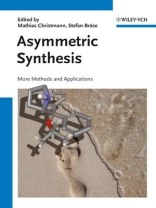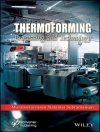After the overwhelming success of Asymmetric Synthesis – The Essentials, displaying a broad range of organic asymmetric syntheses, this is the second edition with latest subjects and authors. While the aim of the first edition was mainly to honor the achievements of the pioneers in asymmetric syntheses, the aim of this new edition was bringing the current developments, especially from younger colleagues, to the attention of students. The format of the book remained unchanged, i.e. short conceptual overviews by young leaders in their field including a short biography of the authors. The growing multidisciplinary research within chemistry is reflected in the selection of topics including metal catalysis, organocatalysis, physical organic chemistry, analytical chemistry, and its applications in total synthesis, materials research and industry.
The prospective reader of this book is a graduate or undergraduate student of advanced organic chemistry as well as the industrial chemist who wants to get a brief update on the current developments in the field.
विषयसूची
CATALYTIC ENANTIOSELECTIVE ALKYLATION OF PROCHIRAL KETONE ENOLATES
Background
Strategy and Results
Asymmetric Allylic Alkylation in Total Synthesis
Conclusions
POINT-TO-PLANAR CHIRALITY TRANSFER IN TOTAL SYNTHESIS: SCALABLE AND PROGRAMMABLE SYNTHESIS OF HAOUAMINE A AND ITS ATROPISOMER
Introduction
Synthetic Strategy Featuring Point-to-Planar Chirality Transfer
Programmable Synthesis of Haouamine A and Its Atropisomer
TETHERED AMINOHYDROXYLATION
Introduction and Background
Tethered Aminohydroxylation
Amide-Based Reoxidants
Evidence for the Mechanism of the TA Reaction
Applications in Organic Synthesis
Conclusion and Future Work
ORGANOCATALYZED TRANSFORMATIONS OF A, B-UNSATURATED CARBONYL COMPOUNDS THROUGH IMINIUM ION INTERMEDIATES
THE RENAISSANCE OF SILICON-STEREOGENIC SILANES: A PERSONAL ACCOUNT
Background
Results
Conclusion
ASYMMETRIC DIENAMINE ACTIVATION
Introduction
Historic Background
Results
Conclusion
ASYMMETRIC BR?NSTED ACID CATALYSIS
Introduction and Background
Strategy
Results
Summary
QUATERNARY STEREOGENIC CENTERS BY ENANTIOSELECTIVE B-CARBON ELIMINATIONS FROM TERT-CYCLOBUTANOLS
Background
Objective: Enantioselective Formation of Quaternary Stereogenic Centers in Combination with Reactive Alkyl-Rhodium
Intermediates
Selective Generation of the Alkyl-Rhodium Species and Its Downstream Reactivities
TOTAL SYNTHESIS OF OSELTAMIVIR AND ABT-341 USING ONE-POT TECHNOLOGY
Introduction
Results
Conclusions
ENANTIOSELECTIVE ANNULATIONS WITH CHIRAL N-MESITYL N-HETEROCYCLIC CARBENES
Introduction
Catalytic Generation of Chiral Enolate Equivalents
Catalytic Generation of Homoenolate Equivalents
Enantioselective Cascade Reactions Catalyzed by Chiral N-Heterocyclic Carbenes
Catalytic Annulations via a, ?-Unsaturated Acyl Azoliums
Conclusions
ASYMMETRIC COUNTERANION-DIRECTED CATALYSIS (ACDC)
Concept
Application of ACDC to Organocatalysis
Application of ACDC to Transition Metal Catalysis
Application of ACDC to Lewis Acid Catalysis
ENANTIOSELECTIVE ORGANO-SOMO CATALYSIS: A NOVEL ACTIVATION MODE FOR ASYMMETRIC SYNTHESIS
Background
Objective
Results
ENANTIOSELECTIVE PASSERINI REACTION
Introduction
Background
Results
Conclusion and Perspective
RAPID ENANTIOMERIC EXCESS DETERMINATION
ASYMMETRIC CATALYSIS OF REVERSIBLE REACTIONS
Thermochemistry of Asymmetric Catalyses Close to the Equilibrium
Kinetic Modeling of a Reversible Asymmetric Catalytic Reaction
Case Study: a Reversible Asymmetric Organocatalytic Reaction
Conclusions
EXPLOITING FLUORINE CONFORMATIONAL EFFECTS IN ORGANOCATALYST DESIGN: THE FLUORINE?IMINIUM ION GAUCHE EFFECT
DUTCH RESOLUTION
CONSTRUCTION OF ANTI-ME-OH VICINAL RELATIONSHIPS IN POLYKETIDES
Introduction
Marshall –
Tamaru Reaction
Conclusions
PHOTOSWITCHABLE GENERAL BASE CATALYSTS
Introduction and Background
Strategy and Results
Outlook
ASYMMETRIC HALONIUM ADDITION TO OLEFINS
Introduction
Intramolecular Lactonizations, Etherifications, and Aminations
Polyene Cyclizations
Intermolecular Additions to Alkenes
Conclusion
CATALYTIC ASYMMETRIC GOSTELI –
CLAISEN REARRANGEMENT (CAGC)
BIOMIMETIC TOTAL SYNTHESIS OF THE PENIFULVIN FAMILY
Introduction
The Penifulvin Family: Isolation and Biogenetic Origin
Total Syntheses of Penifulvins A, B, and C
Summary
CATALYST-CONTROLLED 1, 3-POLYOL SYNTHESES
ENANTIOSELECTIVE CARBONYL ALLYLATION AND CROTYLATION FROM THE ALCOHOL OXIDATION LEVEL VIA C?C BOND FORMING TRANSFER HYDROGENATION
Introduction and Background
Strategy
Results
STEREOSELECTIVE SYNTHESIS WITH HYPERVALENT IODINE REAGENTS
ASYMMETRIC GOLD-CATALYZED REACTIONS
Introduction
Diphosphine-Gold Complexes in Enantioselective Catalysis
Monophosphine-Gold Complexes in Enantioselective Catalysis
ASYMMETRIC CATALYSIS IN THE TOTAL SYNTHESIS OF LIPIDS AND POLYKETIDES
Background
Tuberculostearic Acid: One Isolated Methyl Group
Ant Pheromones: Vicinal Methyl Branches
Deoxypropionates: 1, 3-Methyl Arrays
Membrane-Spanning Lipids: 1, 4-Dimethyl Units
Saturated Isoprenoids: 1, 5-Methyl Arrays
THE EVOLVING ROLE OF BIOCATALYSIS IN ASYMMETRIC SYNTHESIS
Background – First- and Second-Generation Biotransformations
Results –
Third-Generation Biotransformations
Conclusions and Future Perspectives
BIFUNCTIONAL THIOUREA CATALYSTS
Background
Results
CATALYTIC ASYMMETRIC (4 + 3) CYCLOADDITIONS USING ALLENAMIDES
Introduction and Background
Strategy
Results
Conclusion
APPLICATION OF THE ACHMATOWICZ REARRANGEMENT FOR THE SYNTHESIS OF OLIGOSACCHARIDES
Introduction
De novo Approach to Carbohydrates
An Iterative Pd-Catalyzed Glycosylation and Bidirectional Postglycosylation
Application to the Synthesis of the Anthrax Tetrasaccharide
ASYMMETRIC C –
C BOND FORMATION USING CHIRAL PHOSPHORIC ACID
Background
Results
Conclusions and Future Perspectives
ASYMMETRIC C –
H BOND FUNCTIONALIZATION
Background
Results
Conclusions and Future Perspectives
ASYMMETRIC C –
C BOND FORMATION USING CHIRAL GUANIDINE CATALYSTS
Background
Catalyst Design and Results
ENANTIOSELECTIVE SYNTHESIS OF LACTONES VIA RH-CATALYZED KETONE HYDROACYLATION
Background and Introduction
Strategy and Results
Conclusions and Future Directions
RADICAL HALOALKYLATION
ASYMMETRIC HYDROVINYLATION OF ALKENES
Introduction
New Protocols for the Heterodimerization of Ethylene/Propylene and Vinylarenes, 1, 3-Dienes, and Norbornene
Catalytic Asymmetric Hydrovinylation Reactions: Effects of Hemilabile Ligands
All-Carbon Quaternary Centers via Catalytic Asymmetric HV
Hydrovinylation (HV) of 1, 3-Dienes and Asymmetric Variations
Asymmetric Hydrovinylation of Unactivated Linear 1, 3-Dienes Using Co(II) Catalysis
Scope and Applications of Hydrovinylation Reactions: Exocyclic Stereocontrol
A Stereoselective Route to either Steroid-C20(S) or -C20(R) Derivatives
Asymmetric Hydrovinylation of Strained Alkenes
Conclusions and Future Perspectives
HETEROCYCLE CONSTRUCTION VIA ASYMMETRIC RHODIUM-CATALYZED CYCLOADDITIONS
Background
Strategy
Results
Application to Other Reactions
Conclusion and Future Perspectives
N-HETEROCYCLIC CARBENE-CATALYZED ALDOL DESYMMETRIZATIONS
Introduction
Strategy and Results
Application to the Syntheses of Bakkenolides I, J, and S
Conclusion
STRATEGIES FOR THE ASYMMETRIC TOTAL SYNTHESIS OF NATURAL PRODUCTS: `’CHIRAL POOL’ VERSUS CHIRAL CATALYSTS
Introduction
Catalytic Stereoselective Total Synthesis
Natural Product Synthesis Starting from Chiral, Nonracemic Starting Materials
Conclusion
DYNAMIC KINETIC ASYMMETRIC TRANSFORMATIONS INVOLVING CARBON –
CARBON BOND CLEAVAGE
Background
Donor –
Acceptor Cyclopropanes as DYKAT Substrates
Lewis Acid Catalysis
Palladium Catalysis
Deracemization of Tertiary Propargyl-Allyl Alcohols via Rhodium-Catalyzed Sequential Rearrangement/Enantioselective Conjugate Addition
Conclusion
IRON-CATALYZED ALLYLIC SUBSTITUTIONS
Allylic Substitutions Catalyzed by the Hieber-Anion [Fe(CO)3(NO)]-
Allylic Substitutions Catalyzed by Fe2(CO)9
ASYMMETRIC CONIA-ENE CARBOCYCLIZATIONS
Introduction and Background: the Conia-ene Reaction
Strategy: Organo/Metal Cooperative Catalysis
Results
TACTICS AND STRATEGIES IN THE TOTAL SYNTHESIS OF CHLOROSULFOLIPIDS
Background
Stereoselective Synthesis of vic-Dichloride Fragments
Total Synthesis of Hexachlorosulfolipid
Conclusions
LINEAR FREE ENERGY RELATIONSHIPS (LFERS) IN ASYMMETRIC CATALYSIS
Introduction and Background
Hammett Electronic Parameters and Their Application to (salen)Mn(III)-Catalyzed Asymmetric Epoxidation Reactions
Relating Br?nsted Acidity to Enantiomeric Ratio in an Asymmetric Hydrogen-Bond-Catalyzed Diels-Alder Reaction
An LFER Describing the Influence of Steric Bulk in a Nozaki?Hiyama –
Kishi Asymmetric Allylation of Acetophenone
Correlating Quadrupole Moment to Enantioselectivity in Cation-p-Mediated Asymmetric Polycyclization
Simultaneously Correlating Hammett and Charton Parameters to Enantioselectivity in Two-Dimensional Free Energy Relationships
Conclusions
ASYMMETRIC DIAMINATION OF ALKENES
Introduction and Background
Strategy
Results
ENZYMATIC ASYMMETRIC SYNTHESIS OF TERTIARY ALCOHOLS
Introduction
Yer E – a Unique Th DP-Dependent Enzyme
Hydroxynitrile Lyases
Conclusion
OXIDATIVE DEAROMATIZATION AND ORGANOCATALYTIC DESYMMETRIZATION
Introduction
Desymmetrization of Cyclohexadienones
A One-Pot Oxidative Dearomatization and Catalytic Desymmetrization
Oxo- and Aza-Michael Additions
Further One-Pot Methods for Oxidative Dearomatization and Catalytic Desymmetrization
Alkylative Dearomatization
Summary
TOTAL SYNTHESIS OF ALL (-)-AGELASTATIN ALKALOIDS
Introduction
Biosynthetically Inspired Plan for Total Synthesis
Total Synthesis of the Agelastatin Alkaloids
लेखक के बारे में
Stefan Brase studied chemistry in Bangor, UK, Marseille, France, and Gottingen, Germany, where he gained his doctorate under Armin de Meijere in 1995. After post-doctoral appointments at Uppsala University, Sweden under J.-E. Backvall and The Scripps Research Institute, La Jolla, USA with K. C. Nicolaou, he began his research career at the RWTH Aachen with Dieter Enders in 1997, obtaining his lecturing qualification in 2001. He became a professor at the University of Bonn that same year and since 2003 he has been Full Professor at the Karlsruhe Institute of Technology. Professor Brase has more than 250 publications to his name and is a recipient of the ORCHEM award. His research interests include methods in drug discovery, combinatorial chemistry with a focus on the synthesis of biologically active compounds, total synthesis of natural products and nanotechnology.
Mathias Christmann studied chemistry at the Technical University of Braunschweig and received a Ph D from the Leibniz University of Hannover with Markus Kalesse. After postdoctoral research with Craig J. Forsyth at the University of Minnesota, USA, he joined the RWTH Aachen University as a Liebig Fellow of the Fonds der Chemischen Industrie, working towards his lecturing qualifi cation under Dieter Enders. In 2008, he was appointed Associate Professor at the Dortmund University of Technology, where he lectures in organic chemistry. Professor Christmann’s research interests include organocatalysis, natural products synthesis and sustainable chemistry.












